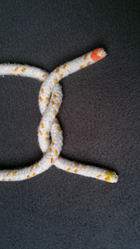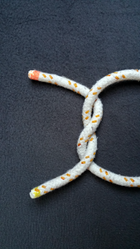Half knot
| Half knot | |
|---|---|

|
|
| Type | Basic form |
| application | Tie knot |
| Ashley No. | 49 |
| English | Half knot |
| List of nodes | |
The half knot is a tying knot that is used to tie up packages, shoe bows and the like. Well-known knots - where the half knot is used - are, for example, the square knot and the shoe knot . In the vast majority of cases, the half knot does not appear as an independent knot.
Knot
The half knot is tied with two rope ends. It can only have two different orientations. When knotting, you either place the left end of the rope over the right or the right end of the rope over the left. The statement left over right is not absolute, it depends on the viewing direction. Therefore, you can tie the knot in four different ways, but ultimately you only get two different knot turns. (see also lay direction ).
Two half knots
Depending on the orientation with which two half knots are tied, there are different knots that have completely different functions:
Square knot , also reef knot
Here the two half knots have different orientations - first placed left over right and then right over left. The ends of the rope are parallel.
Thief's knot If you do not tie a half knot because you do not tie both ends of the rope around each other, the ends of the rope slip out under load and the knot loosens by itself. The ends of the rope are diagonally opposite.
Further application examples
- Knot with at least half a knot
Demarcation
The half knot is often confused with the overhand knot and the half knot . These three nodes are very similar in structure, but have clearly different uses. See also the section: Delimitation of the overhand knot!
Direction of impact
In technical terms, one can find two lay directions - independent of the viewing direction - at the half knot , one with an “ S ” or one with a “ Z ” lay direction.
You can see in the gallery below that there are only two differently tied knots. Fig. 1 shows the same lay direction as Fig. 2 and Fig. 3 shows the same lay direction as Fig. 4. The other is only laid with the other end of the rope (red or yellow). The direction of impact is the same.
Image 2 rotated by 90 ° in UZS.
A “ Z ” tied half knot (the rope with the yellow end shows the letter Z ).
See also
Individual evidence
- ↑ Clifford W. Ashley : The Ashley Book of Knots . Translated by Gerhard Meyer-Uhl. Edition Maritim, Hamburg 1999, ISBN 3-922117-37-6 , pp. 24 (# 49) (English: The Ashley Book of Knots .).
- ↑ Geoffrey Budworth: The best knots for everyday life, leisure and sport . Bassermann, Munich 2005, ISBN 978-3-8094-1793-4 , p. 15 (English: The Really Useful Knot Book .).
- ↑ Clifford W. Ashley : The Ashley Book of Knots . Translated by Gerhard Meyer-Uhl. Edition Maritim, Hamburg 1999, ISBN 3-922117-37-6 , pp. 24 (# 46-48) (English: The Ashley Book of Knots .).
- ^ JC Turner and P. van de Griend: History and Science of Knots (Series on Knots and Everything Volume 11). Google Books, accessed March 4, 2017 (page 47).
literature
- Clifford W. Ashley : The Ashley Book of Knots . Over 3800 knots. How they look like. What they are used for. How they are made. Translated by Gerhard Meyer-Uhl. 6th edition - Hamburg: Edition Maritim 1999, Einheitssacht. The Ashley book of Knots. (Original edition 1944) ISBN 3-922117-37-6 .
- Gordon Perry, Steve Judkins: Knots, Splicing, Fancywork. Delius Klasing Verlag, Bielefeld 1972, ISBN 978-3-7688-3335-6 .
- Kai Lund: Linen cords. Delius Klasing Verlag, Bielefeld 1972, ISBN 978-3-7688-0140-9 .
- Kaj Lund: Fancywork. Playing with cordage. Delius Klasing Verlag, Bielefeld 1977, ISBN 978-3-7688-0172-0 .
- Eva Andersen: Macrame as an art and hobby . Falken Verlag 1980, ISBN 3-8068-4085-7 .
- Geoffrey Budworth: The best knots for everyday life, leisure and sport . Bassermann, Munich 2005, ISBN 978-3-8094-1793-4 (English: The Really Useful Knot Book .).
- Geoffrey Budworth, Jason Dalton: Knots: 200 Practical Knots . Librero, 2016, ISBN 978-90-8998-727-3 .
- Erich Sondheim: Knots - Splicing - Rigging. Delius Klasing Verlag, Bielefeld 2001, ISBN 978-3-87412-171-2 .
- Maria Constantino: The great knot manual. Bassermann Verlag, 2002, Random House Munich publishing group, ISBN 978-3-8094-1279-3 .
- JC Turner and P. van de Griend: History and Science of Knots . In: Series on Knots and Everything . Volume 11. Singapore 1996, ISBN 978-981-02-2469-1 .
- Harry Asher: The Alternative Knot Book . Sheridan House Inc., 1989, ISBN 978-0-911378-95-5 .













